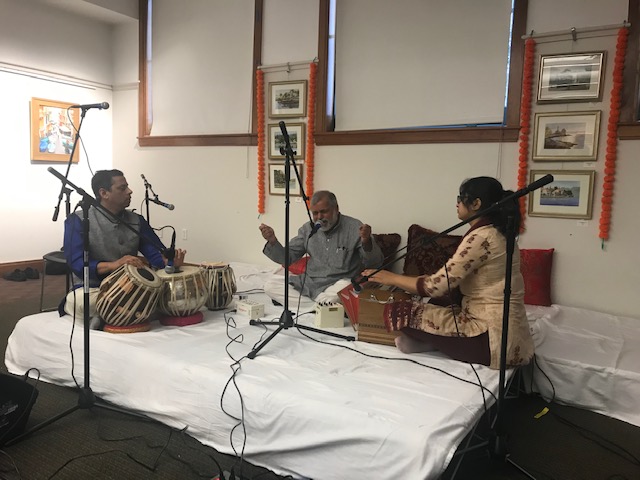When I ascended onto the stage with four musician colleagues with the idea of presenting Indo-Jazz fusion, I did so without having a complete understanding of what the final outcome would be. Would it come together and please me and the listeners OR would it be chaotic? The fusion segment was staged in front of a live audience at LearnQuest Academy’s pre-conference event held on January 26 at Cary Memorial Library, Lexington, Mass.
Preceding the Indo-Jazz fusion segment, there were three other presentations – one, a lecture-cum- demonstration on “Dhrupadâ€, India’s oldest living Hindustani music tradition by yours truly along with the vocal presentation of two Dhrupads in ragas Jog and Charukeshi by twenty members of New England Dhrupad Ensemble; two, a masterful Santoor instrument recital by Shri Nitin Pandit featuring alap, jod, jhaala and gat in raga Madhuvanti and a dhun in Mishra Shivranjani as well as three, a melodious khyal presentation in raga Patdeep by Shri Pradeep Shukla with Shri Rajesh Pai’s support on the tabla.
By 3:30pm Cary Memorial Library’s meeting hall was packed with music lovers who had warmed up nicely and were eager to listen to the concluding segment, which was the Indo-Jazz fusion segment. The featured artists were Phil Scarff on the saxophone, Nitin Pandit on the santoor, Rajesh Pai on the tabla, Pradeep Shukla as the male vocalist and myself as the female vocalist.
The first half of the fusion segment brought five musicians together in solo explorations of Bhimpalasi raga tied through a sixteen beat cycle taal framework. The second and concluding half had free improvisation, layakari (play with rhythm) on the santoor, the use of tarana words, sargam (solfege), aakaar alaaps, improvisation on the tabla, the saxophone taking off on a rapid flights into the upper octave and descending back to the tonic journeying through Bhimpalasi terrain with great ease.
How the team of five musicians decided on what to bring to the audience makes for an interesting story.
A few members of the fusion team met at LearnQuest the previous evening. I joined the conversation by calling in on the phone. After some deliberation of what might work as a suitable raga to present, we settled on the afternoon raga Bhimpalasi. We brainstormed on choosing a traditional Hindustani composition everyone was familiar with and decided on the traditional cheez (composition) “Ja Ja Re Upnay Mandarva†set to sixteen beat cycle teentaal. “If we are going to play this composition through the duration of the musical segment, we really cannot call it Indo-jazz†said saxophonist Phil. He also added “In the absence of a Western drumset, there should be some variation in what is played on the tabla – it cannot be 16 beat teentaal the entire time because that will be turn it into a Hindustani presentation.â€
“How can we add elements of Jazz?†was the next logical question from the Hindustani vocalists. After some discussion, the team came up with a plan. We would start with brief alaap segments exploring the Bhimpalasi raga terrain, then present the composition “Ja Ja Re†together, then go around in a clock-wise arrangement with each of the participants doing impromptu solos of alaaps (slow melodic sentences) and taans(fast melodic sentences) – all set to sixteen beat cycle teentaal. To add in Western Jazz elements, we would add in a section of free exploration by all musicians on stage with looser restrictions on staying within the Bhimpalasi raga framework. A “vamp†– an arrangement that is played over and over, waiting for each player to do a brief improvisatory solo would be introduced as the common thread in the presentation. The percussionist would change from traditional sixteen beat cycle and play a variant of a four by four arrangement. There would be freedom for all musicians to perform in a simultaneous fashion. We planned on concluding with a tihai arrangement, which is the repetition of a specific melodic and rhythmic pattern thrice.
Did the fusion happen on stage as planned on the previous day? It more or less did. However, it was filled with surprise and new discoveries along the way. The fact that the improvisations were spontaneous led to their coming together at times with some amount of coherence and at other times creating a bit of confusion. What was nice was that it was received well by the listeners.
“It was simply awesome†said Xinghua Li, who attended the concert. “I could completely see the Western Jazz approach in how the saxophonist played. The end could perhaps have been planned in a more dramatic manner†said listener Ryan Mbira. “Mazaa aaya (enjoyed it)†said sound engineer Jawed Wahid. “Cannot not believe it was impromptu†said listener Amita Kumar.
LearnQuest Conference committee member Heramb Bhide thanked concert attendees, participating artists, volunteers, sound engineer Matthew, Cary Memorial library hosts and informed attendees about the main LearnQuest event which is to take place on the weekend of March 27, 28 and 29, 2020 at Regis College, MA. Nearly 50 musicians are expected to participate in the three day music festival that will feature among several presentations, maestros of Hindustani music such as vocalist Padmabhushan Ajoy Chakraborty, percussionist Anindo Chatterjee, Carnatic vocalists Vidushi Aruna Sairam and Aparna Balaji, instrumentalist Dr. George Ruckert on the Sarod and also a presentation on choreography by Vidishi Gowri Ramnarayan. For more details, visit www.learnquest.org

